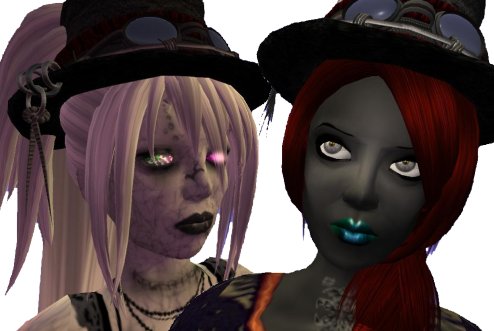Since virtual environments started getting noticed by the early adopters, there has been some discussion about social mores in and out of virtual environments. In particular this applies to users trying out avatars of a different gender, race, or overall look, to their regular atomic world selves. Educators and academics in general have noted students and other users typically bring their prejudices and biases with them into virtual environments, but that they also sometimes take what they have learned in virtual environments back into the atomic world with them.
Unfortunately, it seems that users open to such experimentation were already quite open-minded. More closed-minded individuals are less likely to experiment, and less likely to lose their prejudices along the way.
I belong to two genres of people which are often vilified and denigrated – I am somewhat Goth, and quite a bit Geek, and I express this both visually and in the way I act, both in virtual environments and atomic worlds. These are two groups I have found to be unpopular with other people, though less so in virtual environments. I had hoped that some of the acceptance from virtual environments might have spilled over into the atomic, but this does not seem to have been true to the extent that I might have hoped for.
Goths and Geeks that I know tend to have some areas of overlap – they tend to be individualists and thinkers, they tend to make up the innovator and early adopter part of the populace, they tend to act and dress distinctively, and they tend to be unpopular with other groups: educators, academics, business people – normal, mainstream folk.
I wondered why. Especially, I wondered why Goths and Geeks should be so unpopular amongst people who use virtual environments, and who are exposed to people with curious looks and outlooks on a regular basis.
This is what I came up with:
We make choices about how we are going to look, act and live our lives. We have made choices independently of our genes, of our circumstances. Other people could also make this choice – but instead they have remained with the cultural ideas and circumstances they were born into. The choice they often make instead is to disparage and utterly reject the people who have decided to live their lives intentionally.
Along similar lines is this thought:
I recently heard someone referring to their IT staff as “the enemy”. As an IT Geek, I found this to be a most off-putting thought. It makes it sound as though I have to wage war whenever I want to get my work done, making my under-paid, over-worked position even worse, and, boy, does it sound unfriendly! Again with the wondering – why?
The IT Geek often has at least two agendas: their own practical agenda (where is the point in having a firewall if you are just going to open ports for people at random?), and someone else’s political agenda – usually their boss, sometimes another member of staff. Rarely does the IT Geek have their own political agenda – if it seems that they do, it’s more likely that they are defending someone else’s policies, or it’s a case of apophenia (seeing patterns where none exist). Also, Geeks are rarely in a position to make policies.
I am a Goth, and a Geek, and I belong to a number of other unpopular sub-groups. I’d love for our society to change, with the assistance of virtual environments, to one that is more tolerant of people who are different, whether that be by birth, environment or choice.
But I’m not holding my breath.

Recent Comments